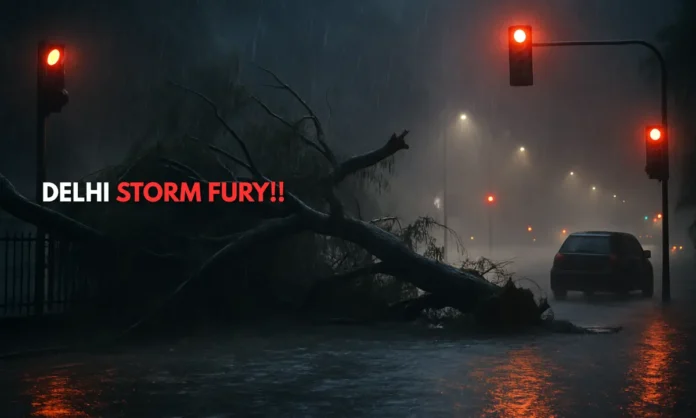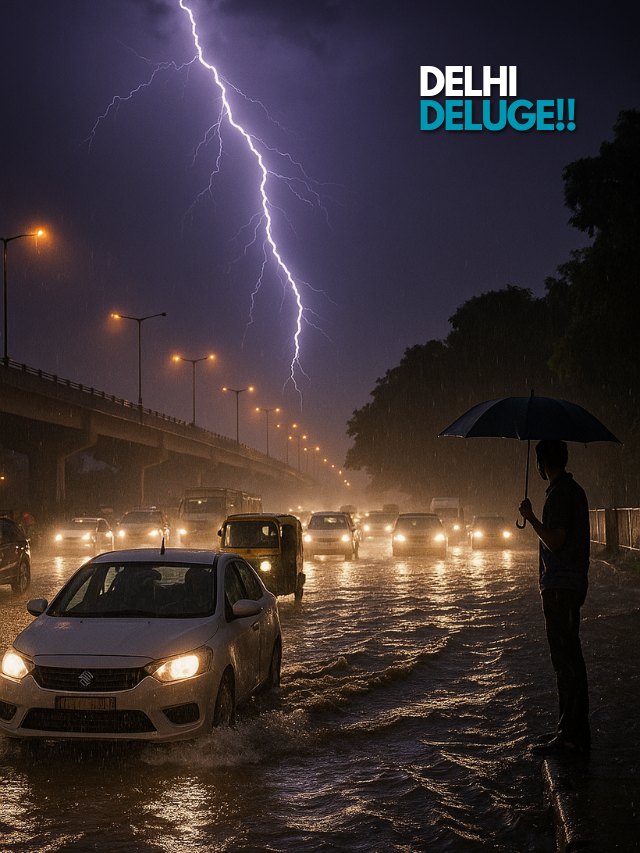SUMMARY
- An unexpected thunderstorm lashed Delhi early Friday, killing four people and injuring one in Dwarka.
- Over 77 mm of rain hit Safdarjung alone, leading to severe waterlogging, widespread flight delays, and red-alert emergency responses.
- Officials face rising questions over the city’s crumbling infrastructure as extreme weather events become the new normal.
When the Sky Broke Over Delhi: A City Brought to its Knees
In the early hours of Friday, Delhi witnessed one of its most devastating pre-monsoon storms in recent memory. What began as a yellow-alert advisory swiftly escalated into a red-alert emergency as gale-force winds and torrential rains pounded the city. Between 2:30 am and 8:30 am, the capital’s key weather stations recorded rainfall totals rarely seen outside monsoon peaks. At Safdarjung, Delhi’s primary weather station, 77 mm of rain fell in just six hours—more than twice the city’s average for the entire month of May.
The chaos unfolded swiftly. A tree collapse in Kharkhari village killed four and left one critically injured. Airports ground to a halt, with at least three flights diverted and over 100 delayed. Traffic bottlenecks stretched for miles across key arterial routes as water inundated major underpasses and intersections. Despite early forecasts, the scale of damage pointed to deeper, systemic failures in Delhi’s emergency response and infrastructure readiness.
This latest storm has once again laid bare how vulnerable Delhi remains to rapid, extreme climate events. As civic authorities scramble to drain waterlogged roads and airports work overtime to resume operations, a difficult question lingers: How much longer can India’s capital afford to be unprepared?
⛈ Delhi Storm Kills Four, 40+ Flights Diverted
— RT_India (@RT_India_news) May 2, 2025
A 26-year-old woman and her three children died on after a tree collapsed onto a tubewell room in Dwarka, amid strong winds and heavy rain.
Delhi-NCR was hit by intense thunderstorms, rainfall, and gusty winds, causing chaos… pic.twitter.com/cqbrfI4Ux1
Dawn of Destruction: Thunderstorm Turns Deadly in Delhi
- Red alert issued after 5:30 am as wind speeds reached up to 80 km/hr across Delhi.
- Four killed in Dwarka after tree collapse; scores of minor injuries and property damage reported.
- Temperatures plunged by 7–10°C within minutes as the storm passed through.
The India Meteorological Department (IMD) initially expected only light thunderstorms, but by 5:30 am, conditions rapidly worsened. Official data confirmed maximum wind speeds of 80 km/hr at Safdarjung and Pragati Maidan. The ferocity of the gusts uprooted trees, toppled signage, and brought fatal consequences to Kharkhari village in Dwarka.
The intense weather also triggered a sharp and sudden temperature drop across Delhi. For example, Lodhi Road witnessed a plunge from 28.2°C to 20.7°C in less than 20 minutes. Senior IMD officials compared this rare May event to the aftermath of Cyclone Tauktae in 2021, warning that climate volatility is becoming the new standard.
Despite the advanced warning, Delhi’s preparation faltered, exposing the fragility of urban safety nets even against predictable seasonal shifts.
A City Submerged: Infrastructure Buckles Under Storm Pressure
- Waterlogging reported across Minto Bridge, ITO, Pitampura, Preet Vihar, and Bhairon Marg.
- Three flights diverted from Delhi Airport; over 100 flight delays early morning.
- No major underpass collapses, but logistical snarls crippled movement across the city.
Videos from dawn showed Delhi’s roads submerged under knee-deep water, bringing traffic to a standstill. Infamous choke points like Minto Bridge, Civil Lines, and Pragati Maidan once again flooded despite annual monsoon preparedness claims by the Delhi government.
Flight operations were severely disrupted at the Indira Gandhi International Airport. Heavy rains and low visibility forced three incoming flights to divert—one to Ahmedabad, two to Jaipur. Officials clarified that no structural damage was reported to Terminal 3, but passenger services faced heavy delays well into the afternoon.
The Public Works Department (PWD) Minister Parvesh Verma inspected the affected areas, admitting localized infrastructure failures such as pipe bursts, drainage blockages, and delayed response timings. His public assurances, however, did little to mask the evident reality: Delhi remains critically unprepared to handle even predictable extreme weather shocks.
Red Flags in the Rain: Climate Change and Urban Fragility Collide
- Delhi’s May 2025 rainfall broke records, more than doubling the monthly average in six hours.
- Infrastructure collapse suggests systemic neglect, not one-off failures.
- Officials call for urgent investment in drainage, stormwater management, and emergency systems.
Climate scientists and urban planners view Friday’s disaster as a grim indicator of worsening trends. Delhi’s base rainfall for May normally hovers around 30.7 mm; Friday alone saw Safdarjung record 77 mm, Lodhi Road 78 mm, and Pragati Maidan over 71 mm.
Senior IMD scientist RK Jenamani stressed that this scale of sudden precipitation and wind velocity used to be considered rare for May but has now become increasingly common. He pointed to urgent needs for adaptive infrastructure: faster drainage systems, stronger building codes, and better emergency warning dissemination.
As Delhi lurches toward another monsoon season, the warning signs are flashing in red. Without robust climate adaptation, every thunderstorm could turn deadly, and every flood could become catastrophic.
A City on the Edge: Delhi’s Race Against the Next Storm
Delhi’s Friday thunderstorm was not just an environmental anomaly—it was a policy failure. It exposed that despite decades of warnings, India’s capital city remains dangerously exposed to the forces of nature, worsened by poor urban planning and slow governmental response.
The human cost—four lives lost, hundreds stranded, flights delayed—is a painful reminder that without urgent action, the next storm could be even deadlier. Delhi stands at a crossroads: invest in resilient, climate-smart infrastructure now or risk sliding into a pattern of perpetual crisis with each coming season.
The storm has passed, but Delhi’s moment of reckoning has only just begun.



